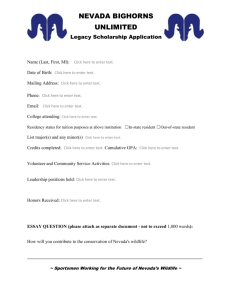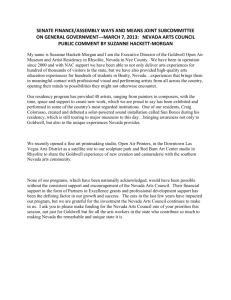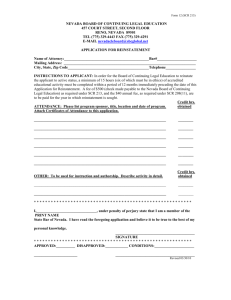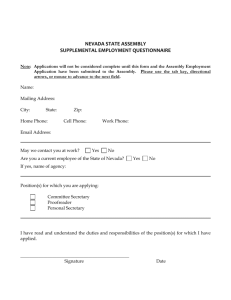An Ordinance amending Section L-II 4.3.18 Wildfire Hazard Areas
advertisement
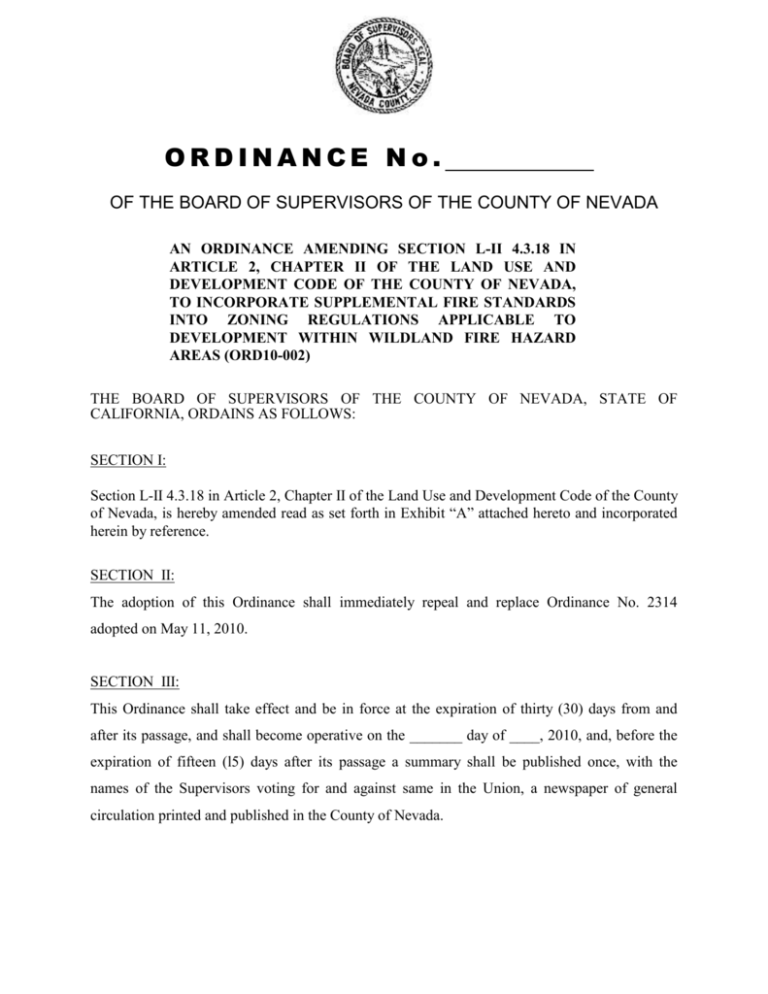
ORDINANCE No. OF THE BOARD OF SUPERVISORS OF THE COUNTY OF NEVADA AN ORDINANCE AMENDING SECTION L-II 4.3.18 IN ARTICLE 2, CHAPTER II OF THE LAND USE AND DEVELOPMENT CODE OF THE COUNTY OF NEVADA, TO INCORPORATE SUPPLEMENTAL FIRE STANDARDS INTO ZONING REGULATIONS APPLICABLE TO DEVELOPMENT WITHIN WILDLAND FIRE HAZARD AREAS (ORD10-002) THE BOARD OF SUPERVISORS OF THE COUNTY OF NEVADA, STATE OF CALIFORNIA, ORDAINS AS FOLLOWS: SECTION I: Section L-II 4.3.18 in Article 2, Chapter II of the Land Use and Development Code of the County of Nevada, is hereby amended read as set forth in Exhibit “A” attached hereto and incorporated herein by reference. SECTION II: The adoption of this Ordinance shall immediately repeal and replace Ordinance No. 2314 adopted on May 11, 2010. SECTION III: This Ordinance shall take effect and be in force at the expiration of thirty (30) days from and after its passage, and shall become operative on the _______ day of ____, 2010, and, before the expiration of fifteen (l5) days after its passage a summary shall be published once, with the names of the Supervisors voting for and against same in the Union, a newspaper of general circulation printed and published in the County of Nevada. PASSED AND ADOPTED by the Board of Supervisors of the County of Nevada at a regular meeting of said Board, held on the day of _____________, _2010_, by the following vote of said Board: Ayes: Supervisors Noes: ATTEST: Absent: CATHY R. THOMPSON Clerk of the Board of Supervisors Abstain: By: Chair DATE 2 COPIES SENT TO EXHIBIT “A” Section L-II 4.3.18 Wildand Fire Hazard Areas A. Purpose. To prevent or minimize the impact of wildland fire hazard associated with development. B. Definitions. C. 1. Dead End Road - A road which has only one point of vehicular ingress/egress, including cul-de-sac and looped roads. 2. Wildland Fire Hazard Areas - Those areas within the unincorporated area of Nevada County that are mapped on the CAL FIRE “Fire Hazard Severity Zone” maps which are rated for wildland fire potential. Standards. 1. 2. All development shall comply with the applicable fire protection-related provisions of the following chapters of the Land Use and Development Code: a. Chapter II: Zoning Regulations, which establishes residential and rural base district side yard and rear yard setback standards. b. Chapter V: Article 5, Fire Safety Standards, which establish fire safe building codes relative to building construction. c. Chapter VII: Street Addressing and Naming, which requires the naming and posting of roads and the posting of street addresses. d. Chapter XVI: Fire Safety Regulations, which establishes regulations for fuel modification, water storage, and driveway construction. e. Chapter XVII: Road Standards, which establishes minimum standards for fire safe road construction and maintenance. Unless otherwise exempted by this Chapter, all discretionary and Administrative Development Permit projects within a high or very high fire hazard zone shall comply with the following standards: a. Create defensible space by removing and reducing brush, flammable vegetation or combustible growth consistent with the provisions of Public Resources Code 4291 and the Nevada County Defensible Space Standard described in General Plan Policy FP10.11.1.1. Defensible space treatment shall be completed, and inspected by the County Fire 1 Marshal or his/her designee, prior to the granting of any occupancy of new structures. b. Provide secondary access where the project is served by a dead-end road that exceeds the maximum length established by County Road Standards, Section L-XVII 3.4.I. Secondary access roads shall be improved to the Fire Standard Access Road standard and is consistent with the provisions of Chapter XVII, County Road Standards. 3. All driveways serving new residential units, and that are between 150 feet and 800 feet in length shall construct a turnout near the midpoint of the driveway. Driveways exceeding 800 feet in length shall provide turnouts no more than 400 feet apart. 4. All discretionary projects within the very high wildland fire hazard area severity zone shall submit a Fire Protection Plan to be approved by the Nevada County Fire Marshal and/or his/her designee. The approved original shall be kept on file at the County Planning Department and an approved copy shall be provided to and kept on file with the appropriate fire district. The plan shall be site specific to the project and shall include the following: a. Identification of the proximity to emergency responders and estimated emergency response times; b. Description of the primary and, if applicable, secondary, access road conditions; c. Identification of the project’s emergency water supply or emergency water storage facilities consistent with Article 4 of Chapter XVI of the Land Use and Development Code; d. Identification of any proposed or required fire sprinkler system; e. Identification of a feasible evacuation plan and/or safe evacuation routes for use by future occupants of the project; f. Identification and use of clustered buildings and/or building sites and where feasible, the use of common driveways and access roads; and g. A Fuels Management Plan that includes: 1) Identification of the project’s defensible space design, consistent with Public Resources Code 4291; 2) Identification of high fuel load areas; 2 3) Provisions to ensure that adequate defensible space is provided including, but not limited to, the use of increased property line setbacks or fuel modification zones or easements around newly created lots; 4) Identification of the mechanism proposed for maintaining defensible space; and 5) Use of fire-resistant plantings for all landscaping required by County Ordinance using the most current Fire-Wise Plant Book prepared by the Fire Safe Council of Nevada County, or similar publication. The above fire prevention measures shall be incorporated into the project unless specific findings can be made and supported by the responsible fire agency which demonstrate that one or more of the Fire Protection Plan components are not necessary because of the project’s location, design and/or specific site features and because the project will not add to the cumulative fire hazard within the project area. 3

